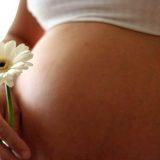Cervical laceration
Prematurity, narrow pelvis, rupture of membranes for 24 hours before delivery, and much more provoking cervical laceration. Bleeding – a common symptom of discontinuities, but not mandatory.
The most common are the lateral radial tears of the cervix.
At first birth, tend to occur superficial side edge tears uterine os. As a result of these tears, usually not exceeding 1 cm, the outer mouth gets subsequently slit shape is a sign of the former birth. Such ruptures are accompanied only spotting in childbirth.
Deeper cervical laceration can capture not only the vaginal part of the cervix to a greater or lesser extent, but spread up to supravaginal part of the neck, on the parameters in the side and down to the vaginal vault. Such ruptures are usually accompanied by bleeding and require emergency treatment. Severe bleeding are rare, and therefore in the old days postpartum cervical laceration is often not diagnosed.
Cervical laceration in the future often lead to chronic endocervicitis, cervical erosion, accompanied by inversion of the mucosa of the cervical canal, which often eroziruetsya.
In multiparous cervical laceration rarer than nulliparous.
Etiology and pathogenesis
Cervical laceration divided into spontaneous and violent.
Cervical integrity during childbirth is preserved under the normal amount of elastic fibers, which anastomoziruya with each other, as if stseplivayut muscle bundles. Reduction in cervical tissue elastic properties, ductility, connective tissue replacement of smooth muscle fibers in chronic inflammatory processes, changes in scarring after surgery, at the age of nulliparous infantilism often lead to tearing of the cervix. In nulliparous after 30 years of cervical laceration occur more frequently than younger people.
Loosening cervical previa child seat is also one of the reasons for its spontaneous ruptures.
When the extensor previa head, large fruit, overly dense head at term pregnancy the cervix is exposed to greater tension and often broken. Rapidly flowing period of exile, during which no time to manifest stretch fabric collar, also accompanied by more frequent breaks neck than normal childbirth occurring. Prolonged labor with a long neck infringement between pelvis and head, accompanied by bleeding cervical tissue, lead to an increase in the number of discontinuities; under these conditions sometimes observed annular cervicectomy.
When discharge of amniotic fluid for 24 hours before the birth of the baby increases the likelihood of cervical fractures.
Narrow pelvis , leading to prolonged childbirth, premature and early rupture of membranes, and often accompanied by an infringement of the cervix between the pelvis and the head, helps her tears.
Cervical laceration found breech is slightly more than the head.
Violent ruptures of the cervix usually arise from operative delivery, which is accompanied by removing the fetus with incomplete disclosure of uterine os or spastic contraction. Gaps in these cases come in as forceps or craniotomy, and the extraction of the fetus pelvic end.
Particularly easy discontinuities arise when there previa child seats. The gap can occur even with such little effort as an attempt to finger extension throat, hanging by skin-head forceps, or relegated hystereurynter fetal stem load of 0.5 kg.
With rupture of the cervix, occurring when turning and subsequent extraction of the fetus and placenta previa incomplete disclosure throat can be strong and even critical bleeding.
Violent ruptures occur more and more often, if there are pathological changes in the tissues of the cervix as a result of degenerative and connecting rebirth. However, violent ruptures may occur without these predisposing factors.
The most common are the lateral radial tears of the cervix, which usually occur in an upward direction, starting from the edge of the external os. In the opposite direction, i.e. downwards, cervix ruptures occur rarely and are a continuation of the lower uterine segment gap. Breaks almost always longitudinal sometimes breaks are stellate forum dramatically deforming neck.
Occasionally there necrotic and rejection front lip and very rare circular takeoff vaginal part of the cervix.
Premature birth and late abortions sometimes occur “central” cervical laceration, in which the gap is located at the rear of the neck 1.5-2 cm above the external os, which remains intact. In such cases the fetus is born through the resulting false passage. In a subsequent on-site gap remains cervicovaginal fistula.
It is considered pathological fractures of the cervix are those who have a length of more than 1 cm Given the depth of the gap, we must distinguish three degrees of discontinuities:
- first degree – cervical laceration on one or both sides of a length of less than 2 cm;
- second degree – breaks more than 2 cm but not reaching 1 cm to arch;
- third degree – deep tears, reaching the roof or going over to him.
Cervical laceration, switching to the vaginal vault, and sometimes spread to the inner uterine mouth and accompanied by hemorrhage in the parametrial tissue.
Clinic and symptomatology
Bleeding is one of the signs of rupture of the cervix. Blood loss can be 300-1000 ml. But one can not diagnose bleeding in many cases, since not all cervical laceration accompanied by bleeding, and if the latter occurs after the birth of the fetus, it is often attributed to the uterus hypotension.
Bleeding usually accompanies deep cervical laceration and sometimes gradually born of the fruit is covered with blood. However, the fracture often presenting part is pressed down, and bleeding of the fetus before birth may be missing. In the same period afterbirth bleeding from the fracture can be mixed with those at atsitonii uterus. For bleeding from the fracture characteristic bright red blood, sometimes flowing stream, well contracted uterus, at the bottom of which stands empty bladder below the navel.
Bleeding occurs due to rupture of cervicovaginal branches of the uterine artery and can take profuse nature, threatening the lives of women. With deep neck rupture reaching the vaginal vault, may be profuse bleeding in the parametrial tissue.
Cervical laceration due to crushing of tissues in their long squeezing not accompanied by bleeding or it is negligible as a result of vascular thrombosis or damage plots neck, on which no major branch vessels.
Recognition of cervical fracture based on the presence of bleeding, which occurs in the period of exile and worse after the birth of the fetus and placenta in particular. In postpartum bleeding may depend on uterine atony, but then the latter will be flabby, its contours vague and fundus rises above the navel.
If the bleeding is slight or non-existent, to recognize cervical laceration can only be seen from it using vaginal mirrors. Introduced into the vagina wide mirror and then grab the cervix or hemorrhoidal vulsella first for both front and rear lip, and then, shifting and stretching the edges of their throat, neck inspect all folds.
Inspection mirrors cervix to hold it at the correct (strict adherence to aseptic techniques, inspection and cervical stitching breaks her placenta immediately after birth) is harmless and does not increase the incidence of post-partum.
Treatment
Treatment of cervical tears should be in their stitching immediately after birth. If the gap is accompanied by heavy bleeding, squeeze out the last and start stitching. Stitching neck rupture shall be subject to strict aseptic technique. Cervix is exposed through vaginal mirrors and captured vulsella the front and rear lip is reduced as much as possible outside and pulled in the opposite location of the break. The first suture is applied to the upper corner of the wound, capturing the entire thickness of the seam in the fabric of the vaginal part of the cervix, with the exception of cervical mucous. To use catgut sutures № 3-4 and steeply curved cutting needles.When it is impossible to impose immediately the first seam on the upper corner of the wound, applied 1-2 suture as close as possible to the top corner and then break while pulling the thread of these seams and sew the top corner of the gap. And poke a needle puncture on each side of the gap is at a distance of 0.5 – 1 cm from the edge, while tightening the seams do not penetrate.Stitching gap leads to stop bleeding, prevents the development parametritis that often arises when nezashitom break. Furthermore, nezashitye breaks followed in the subsequent development endocervicitis, erosion and ectropion of cervix.
With rupture of the cervix, extending above the internal os or accompanied by extensive hemorrhage in the parametrial tissue, through the vagina is very difficult to make a break and reliable stitching stop the bleeding. Therefore, in such cases, the most desirable is the use of laparotomy, during which it is possible reliably to stop bleeding, to remove a hematoma, and then perform stitching breaking.
Prophylaxis
Prevention of cervical tears should be administered in the correct delivery, careful operative delivery produced only with adequate obstetric conditions. You can not produce fruit extract with insufficient disclosure throat. If there are serious indications for forceps for incomplete disclosure of the pharynx, the pre to prevent rupture of the neck with scissors cut through the edge of the throat on both sides, right and left.
Especially be careful delivery is previa child seats. Rotate the fetus at part of the uterine mouth with placenta previa because of the extremely poor prognosis for the fetus is rarely used and usually when severe prematurity. If the turn is still applied, it should be remembered NN rule Fenomenova: “When placenta previa please turn brings down the leg, but do not remove.” Find and load to the leg EYELET contraindicated, but if the bleeding does not stop after removing the legs, we have to suspend the weight (200g).













